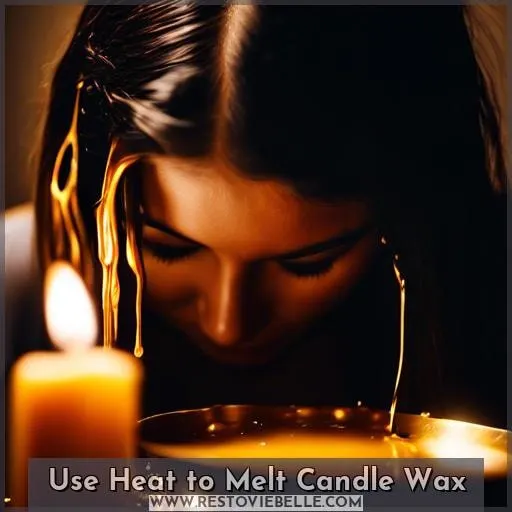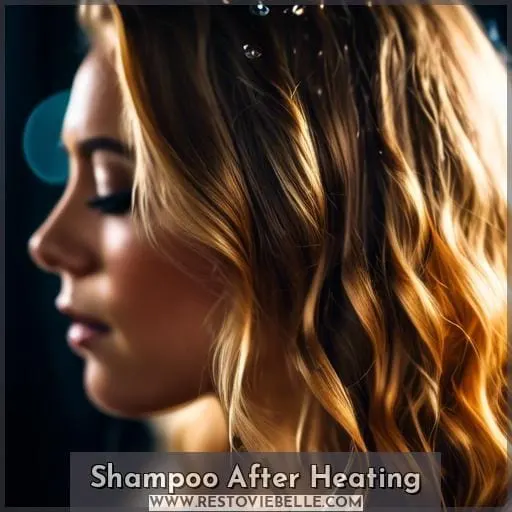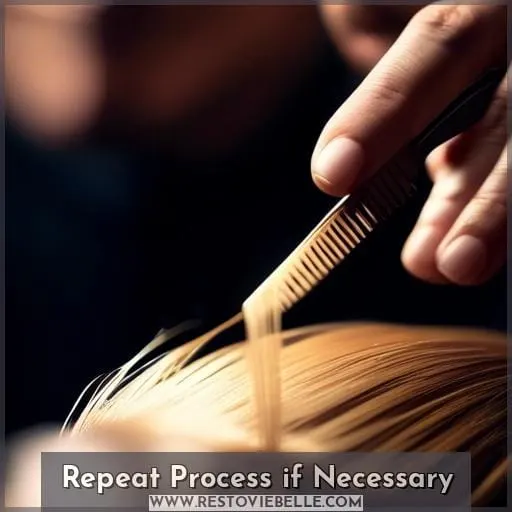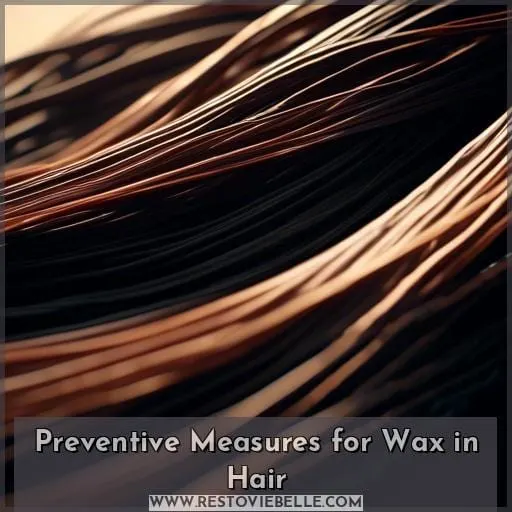This site is supported by our readers. We may earn a commission, at no cost to you, if you purchase through links.
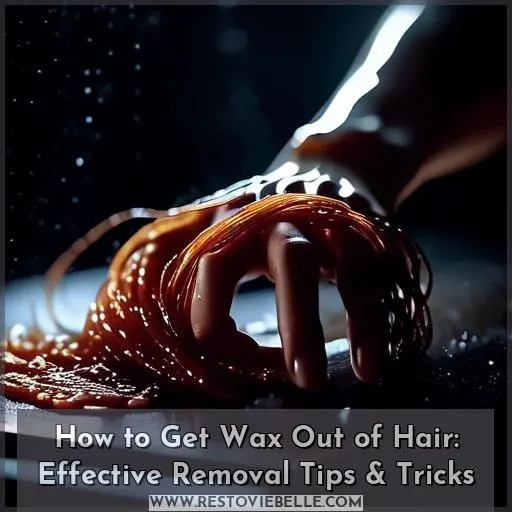 Accidentally getting wax in your hair can feel like a sticky nightmare, but don’t panic! You’ve got several effective tricks up your sleeve to tackle this mess.
Accidentally getting wax in your hair can feel like a sticky nightmare, but don’t panic! You’ve got several effective tricks up your sleeve to tackle this mess.
From applying shampoo to dry hair to using heat to melt the wax away, there are straightforward steps to free your locks from wax’s clingy grip.
Plus, with preventive measures, you can avoid future wax mishaps. Dive into these tips and tricks to safely and effectively remove wax from your hair, ensuring your strands stay smooth and clean.
Yes, you can get wax out of hair by applying oil to break down the wax or using a hot towel to loosen its grip, then shampooing your hair to remove any residue.
Table Of Contents
- Key Takeaways
- Apply Shampoo to Dry Hair
- Use Heat to Melt Candle Wax
- Shampoo After Heating
- Repeat Process if Necessary
- Preventive Measures for Wax in Hair
- Frequently Asked Questions (FAQs)
- Can certain types of hair wax cause discoloration or damage to hair?
- Are there any specific hair types or textures that require a different approach to wax removal?
- How can I prevent hair wax from causing dandruff or scalp dehydration?
- Is it safe to use household oils, like cooking oil, for wax removal from hair?
- What are the risks of using heat tools for wax removal, and how can I mitigate them?
- Conclusion
Key Takeaways
- Use oil (such as baby oil, olive oil, or specialized hair oils) to create a barrier and soften the wax, making it easier to remove from hair. Warm the oil for better penetration and spread it thoroughly over the waxed area.
- Apply heat to melt the wax, either by using a blow dryer on low heat, wrapping hair in a hot towel, or cautiously using a heat gun. This method helps in loosening the wax from the hair.
- After heating, apply shampoo directly to dry hair, focusing on areas with wax. Massage the shampoo thoroughly into the hair and rinse with hot water to remove the wax. A clarifying shampoo may be used for stubborn residues.
- If necessary, repeat the process by reheating the oil if it has cooled, reapplying it to the affected area, and using a hot towel to soften the wax again. After successfully removing the wax, moisturize the hair.
Apply Shampoo to Dry Hair
To remove wax from hair without cutting or ripping it out, you can use a combination of heat and oil. Heat helps to melt and make the wax pliable, while oil creates a barrier that reduces wax’s adhesion to the hair.
-
Oil Application: Choose an oil such as baby oil, olive oil, or hair oil to create a barrier between the wax and the hair. Warm the oil slightly by rubbing it in your hands or warming it in the microwave.
-
Oil and Wax Interaction: Apply the warmed oil to the waxed area of the hair and spread it in one direction to ensure it covers the wax thoroughly.
-
Heat Application: Use a blow-dryer on a low heat setting to gently heat the wax, which will loosen its grip on the hair. Alternatively, you can use a hot towel to wrap around the hair, which will also help in making the wax pliable.
-
Washing Out Wax: Since water alone isn’t effective in removing wax, after using the oil and heat method, proceed to wash the hair with warm water. Utilize a clarifying shampoo to help remove any wax residues and build-up. After shampooing, apply a conditioner to restore moisture to the hair.
-
Prevention: To prevent wax from getting into unwanted areas, take your time during application, use precise applicators like flat-rounded wooden wax applicators, and consider spritzing a little oil or pre-wax cleaner on the area to be waxed. Be careful to avoid getting these products on areas you intend to wax.
In conclusion, if you find yourself with wax in your hair, don’t panic. Employ the use of oil and heat to effectively remove the wax without causing damage to your hair.
Use Heat to Melt Candle Wax
After applying shampoo to dry hair, the next step in tackling that stubborn candle wax is to bring in the heat. Think of wax as that uninvited guest at a party—it won’t leave until things heat up. So, grab your trusty blow-dryer, and let’s show that wax the door. Set your blow-dryer on a low heat setting to avoid any hair horror stories and aim it at the waxy area.
The warmth will coax the wax into a more pliable state, making it easier to bid farewell.
If you’re more of a spa enthusiast, a warm towel might be your tool of choice. Dip a towel in hot water, wring it out, and wrap it around the waxy hair like a cozy cocoon. Give it a few minutes, and the heat will work its magic, softening the wax. For those who are a bit more adventurous, or if you’re dealing with a wax calamity that’s tougher than a two-dollar steak, a heat gun might be your weapon of choice.
But be cautious—this isn’t a toy, and you don’t want to end up cooking more than just the wax.
In the event that you’re in a DIY mood and have some wax to melt, you might even consider using the microwave. Just be sure you’re not microwaving your hair—save this method for melting wax in containers as per the instructions.
Remember, when it comes to removing wax from hair, patience is a virtue, and heat is your best ally. So, whether you use a hair dryer, a warm towel, or even a heat gun, take it slow and steady, and you’ll have that wax out in no time.
Shampoo After Heating
After you’ve used heat treatment to make the wax in your hair pliable, it’s time to bring in the big guns: shampoo.
- Apply a generous amount of shampoo directly to your dry hair, focusing on the waxy areas. Think of it as a pre-wash wax attack.
- Massage the shampoo into your hair with gusto, covering every strand like a protective barrier against stubborn wax.
- Rinse with hot water, as if you’re melting away your troubles (and the wax). Just be careful not to scald yourself!
- If the wax is playing hard to get, repeat the process. Persistence is key, and your hair will thank you for it.
Repeat Process if Necessary
If you find that wax is still clinging to your hair after the initial removal attempt, don’t throw in the towel just yet. Sometimes, it takes a bit more elbow grease to get the job done. Remember, patience is a virtue, especially when dealing with sticky situations.
Reheat the oil if it has cooled down, and reapply it to the affected area, ensuring you’re creating that crucial oil barrier between the wax and your hair. A hot towel can also be your ally here, helping to make the wax more pliable with its low heat embrace.
If the wax is playing hard to get, a clarifying shampoo might just be the ticket to evicting those stubborn residues. And don’t forget to follow up with a moisturizing conditioner to soothe your hair after the ordeal.
In the case of wax finding its way onto clothes or surfaces, similar principles apply—heat to melt, oil to dissolve, and patience to see it through. For those tougher scenarios, like hard wax or roll-on wax, you might need to repeat the process a few times, but with persistence, you’ll come out victorious.
Preventive Measures for Wax in Hair
To prevent future incidents of wax getting into your hair, a little pre-wax preparation can go a long way. Before you even heat up that soft wax, make sure you’re armed with the right waxing technique.
It’s like painting a masterpiece – you wouldn’t start without priming your canvas, right? Similarly, consider spritzing a bit of hair oil on the surrounding skin to create a protective barrier. This way, if wax decides to go rogue, it’ll slide off your skin like water off a duck’s back.
When it comes to applying the wax, think of it as a first date – go slow, be gentle, and use precise applicators to avoid any awkward mishaps. And remember, if you do end up with a bit of wax on skin, a dab of post wax oil can save the day by soothing the area and making cleanup a breeze.
In the end, it’s all about that post-wax care. Treat your skin like royalty with a little pampering to keep it calm and collected. By following these steps, you’ll not only prevent wax from staging a hair rebellion but also keep your skin feeling like it’s on cloud nine.
Frequently Asked Questions (FAQs)
Can certain types of hair wax cause discoloration or damage to hair?
Yes, certain types of hair wax can cause discoloration or damage to hair, especially if the wax is too hot. This can happen when applied multiple times to the same area, leading to skin trauma and post-inflammatory hyperpigmentation (PIH).
Are there any specific hair types or textures that require a different approach to wax removal?
Curly or coily hair types might need a gentler touch when removing wax. Their intricate patterns can trap wax more stubbornly, making it trickier to clear without causing tangles or breakage.
Stick to low heat and patience; it’s not a race!
How can I prevent hair wax from causing dandruff or scalp dehydration?
To keep your mane’s ship sailing smoothly and avoid the dandruff doldrums or scalp dehydration, think of your hair like a garden that needs just the right amount of water.
Too little hydration, and your scalp turns into a desert, inviting dandruff to dance. So, drink up the H2O to keep your scalp’s ecosystem in harmony and use hydrating shampoos to maintain moisture balance.
This way, you’ll keep the flakes at bay and your scalp as lush as a tropical rainforest.
Is it safe to use household oils, like cooking oil, for wax removal from hair?
Yes, it’s safe to use household cooking oils, like olive or vegetable oil, to remove wax from your hair.
These oils can effectively break down the wax, making it easier to comb out.
What are the risks of using heat tools for wax removal, and how can I mitigate them?
Using heat tools like hairdryers can be a double-edged sword. On one hand, they’re fantastic for getting that wax to bid adieu, but on the flip side, they can singe your hair or scalp if you’re not careful.
The trick is to keep the dryer moving and not let it linger too long in one spot. Also, using a lower heat setting can help prevent your hair from becoming as dry as a desert.
Conclusion
With nearly 46% of women preferring waxing as their primary hair removal method, it’s clear that achieving smooth, hair-free skin is a priority for many.
If you’ve found yourself in a sticky situation with wax in your hair, don’t fret. The steps outlined, from applying shampoo to dry hair to using heat and repeating the process if necessary, are your roadmap to freedom from wax’s clingy grip.


